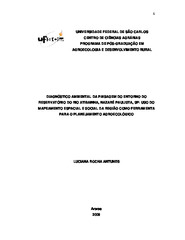Diagnóstico ambiental da paisagem do entorno do reservatório do Rio Atibainha, Nazaré Paulista, SP: uso do mapeamento espacial e social da região como ferramenta para o planejamento agroecológico
Abstract
The mapping of land use along with the characterization of the farmers in the local context and their perception of the environment around them are presented as a fundamental approach to understanding the consequences of intense expansion of human activities in rural areas. This work presents a diagnosis of uses of land in the region of contribution of Atibainha Reservoir, in Nazaré Paulista city (SP), from the System of Water Supply Cantareira, in order to identify key elements of the regional landscape through the analysis of thematic maps and socioeconomic characterization of the local farmers. The diagnosis of the landscape used tools of Geographical Information Systems (GIS), using the ESRI software Arcmap. It was identified six categories of land use: eucalyptus, F1 forest, forest F2, exposed soil, pasture and abandoned area. The forest F1 classified forests which area in the initial stage of regeneration, with a lot of human influences and forest F2 were classified as a forest in medium stage of regeneration, in a better state of preservation. Image analysis described that almost 43% of the total area around the Atibainha Reservoir are permanent preservation areas (PPAs), and 42% corresponding to the classification of forest F2. This highlights the fact that most areas of PPAs corresponds to the environmental legislation enforce to reservoirs areas, this is until 100 meters of its margins. Found the same scenario have shown a significant proportion of forests, all categories of PPAs had been evaluated without approximately 50% of natural cover and isolation of remaining forest is in the structure of the local landscape, which is due to the incorporation of agricultural activities predominant, as pasture and eucalyptus. While agriculture receives less attention than the importance of forests in the maintenance of natural resources and conservation of biodiversity, the agriculture is in close relationship with the environmental resources, both in the use of these resources, such as landscaping organization that are require when this human activity are present in a region. Meanwhile, interviews with landowners identified that the forest is classified as obstacle to development of economic activities of the establishment, ie the existence of the forest haven t allowed the expansion of agriculture activity. It also addressed the context of the forest in the everyday people. There was no understanding in various aspects of the forest in the daily lives of farmers, largely because it did not identify any environmental benefit of the forest to the rural properties. Therefore, the reduction of environmental problems in the region requires change on many levels, as the organization and collective enforcement. For this part, the agroecology is shown as an alternative to regional agricultural production and the rescue of traditional knowledge which incorporate more environmental and social effective ideas on local agriculture. And still because of the natural features, forest management activities with the ecological restoration, especially in areas of permanent preservation and the involvement and understanding of the needs for the population that lives there becomes a way for effective policies implementation to the change of regional landscape organization.
